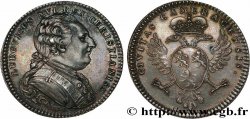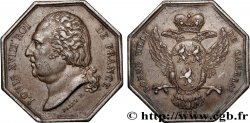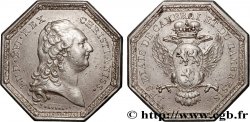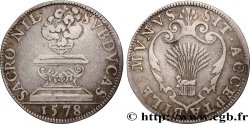fjt_015094 - NORD DE LA FRANCE (NOBLESSE ET VILLES DU...) Charles d'Orléans - Saint - Albin, archevêque de Cambrai 1726
недоступный.
Товар уже продан в нашем интернет-магазине (2009)
Цена: : 380.00 €
Товар уже продан в нашем интернет-магазине (2009)
Цена: : 380.00 €
Тип Charles d'Orléans - Saint - Albin, archevêque de Cambrai
Дата: 1726
Металл: silver
Диаметр: 31 mm
Ориентация осей монеты: 6 h.
Вес: 12,45 g.
Век: cannelée
Редкость: R3
Ссылки в каталоге: :
Лицевая сторона
Аверс: легенда: CARD D G ARCH DVX CAM PAR FR 1726.
Аверс: описание: Buste de Ch. d'Orléans-Saint-Albin.
Обратная сторона
Реверс: легенда: SACERDOS ET PRINCEPS.
Реверс: Описание: Armes de Ch. d'Orléans-Saint-Albin, avec ses attributs.
Реверс: перевод: Prêtre et duc.
Комментарий
On notera le poids particulièrement élevé du jeton de ce prince.
Charles de Saint-Albin, « bâtard fort bien fait » selon Saint-Simon[1], était le fils illégitime du Régent de France et d’une danseuse de l’opéra, Florence Perrin (v.1660-av.1716), elle-même fille d’un cabaretier. Bien que rejeté de la famille royale par Louis XIV (son père le reconnut pourtant en juillet 1706 et le légitima en 1722), il fut poussé vers une carrière ecclésiastique sans grand enthousiasme de la part de l’intéressé qui se trouvait davantage passionné par la théologie[2].
Abbé de Saint-Ouen de Rouen en février 1716[3], bientôt évêque de Rouen après avoir été ordonné prêtre à Saint-Cloud, le 20 septembre 1721, il fut nommé à l’évêché de Laon le 6 janvier 1721 et confirmé le 14 janvier 1722.
Saint-Albin fut fait duc et Pair de France le 26 avril 1722 et obtint, grâce à son père, l’archevêché de Cambrai, le 17 octobre 1723 (consécration le 20 décembre), titre que détenait le défunt Guillaume Dubois[6].
Sa grand-mère, la princesse Palatine, était très éprise de lui et dérogea ainsi au dédain que lui inspirait les bâtards de son beau-frère, Louis XIV[7]. Le 30 octobre 1721, elle confie ainsi son capitaine des gardes[8] : « Il m’est le plus cher puisque je le considère comme le plus sûr des bâtards de mon fils ; depuis l’enfance il s’est attaché à moi plus que les autres. Je voudrais bien que mon fils le légitime »[9]. Saint-Simon réunira Madame et son petit-fils en relatant les circonstances qui amenèrent la duchesse d’Orléans à assister à la soutenance de la thèse[10] du jeune abbé à la Sorbonne, le 16 février 1718 [11].
Ne pas manquer la suite de cette biographie extraordinaire avec extraits de Saint Simon à http://fr.wikipedia.org/wiki/Charles_de_Saint-Albin .
The particularly high weight of this prince's token should be noted..
Charles de Saint-Albin, \\\"a very well-made bastard\\\" according to Saint-Simon[1], was the illegitimate son of the Regent of France and an opera dancer, Florence Perrin (c.. 1660 BC. 1716), herself the daughter of a tavern keeper. Although rejected from the royal family by Louis XIV (his father nevertheless recognized him in July 1706 and legitimized him in 1722), he was pushed towards an ecclesiastical career without much enthusiasm on the part of the person concerned who found himself more passionate about theology[2].
Abbot of Saint-Ouen de Rouen in February 1716[3], soon to be Bishop of Rouen after being ordained priest at Saint-Cloud on September 20, 1721, he was appointed to the bishopric of Laon on January 6, 1721 and confirmed on January 14, 1722.
Saint-Albin was made Duke and Peer of France on April 26, 1722 and obtained, thanks to his father, the archbishopric of Cambrai on October 17, 1723 (consecration on December 20), a title held by the late Guillaume Dubois[6].
His grandmother, the Princess Palatine, was very fond of him and thus departed from the disdain she felt for the bastards of her brother-in-law, Louis XIV[7]. On October 30, 1721, she confided to her captain of the guards[8]: \\\"He is the dearest to me since I consider him the most reliable of my son's bastards; since childhood he has been more attached to me than the others. I would like my son to legitimize it\\\"[9]. Saint-Simon will bring Madame and her grandson together by relating the circumstances which led the Duchess of Orléans to attend the defense of the young abbot's thesis[10] at the Sorbonne, on February 16, 1718 [11].
Don't miss the rest of this extraordinary biography with excerpts from Saint Simon at http://fr. Wikipedia. org/wiki/Charles_de_Saint-Albin
Charles de Saint-Albin, « bâtard fort bien fait » selon Saint-Simon[1], était le fils illégitime du Régent de France et d’une danseuse de l’opéra, Florence Perrin (v.1660-av.1716), elle-même fille d’un cabaretier. Bien que rejeté de la famille royale par Louis XIV (son père le reconnut pourtant en juillet 1706 et le légitima en 1722), il fut poussé vers une carrière ecclésiastique sans grand enthousiasme de la part de l’intéressé qui se trouvait davantage passionné par la théologie[2].
Abbé de Saint-Ouen de Rouen en février 1716[3], bientôt évêque de Rouen après avoir été ordonné prêtre à Saint-Cloud, le 20 septembre 1721, il fut nommé à l’évêché de Laon le 6 janvier 1721 et confirmé le 14 janvier 1722.
Saint-Albin fut fait duc et Pair de France le 26 avril 1722 et obtint, grâce à son père, l’archevêché de Cambrai, le 17 octobre 1723 (consécration le 20 décembre), titre que détenait le défunt Guillaume Dubois[6].
Sa grand-mère, la princesse Palatine, était très éprise de lui et dérogea ainsi au dédain que lui inspirait les bâtards de son beau-frère, Louis XIV[7]. Le 30 octobre 1721, elle confie ainsi son capitaine des gardes[8] : « Il m’est le plus cher puisque je le considère comme le plus sûr des bâtards de mon fils ; depuis l’enfance il s’est attaché à moi plus que les autres. Je voudrais bien que mon fils le légitime »[9]. Saint-Simon réunira Madame et son petit-fils en relatant les circonstances qui amenèrent la duchesse d’Orléans à assister à la soutenance de la thèse[10] du jeune abbé à la Sorbonne, le 16 février 1718 [11].
Ne pas manquer la suite de cette biographie extraordinaire avec extraits de Saint Simon à http://fr.wikipedia.org/wiki/Charles_de_Saint-Albin .
The particularly high weight of this prince's token should be noted..
Charles de Saint-Albin, \\\"a very well-made bastard\\\" according to Saint-Simon[1], was the illegitimate son of the Regent of France and an opera dancer, Florence Perrin (c.. 1660 BC. 1716), herself the daughter of a tavern keeper. Although rejected from the royal family by Louis XIV (his father nevertheless recognized him in July 1706 and legitimized him in 1722), he was pushed towards an ecclesiastical career without much enthusiasm on the part of the person concerned who found himself more passionate about theology[2].
Abbot of Saint-Ouen de Rouen in February 1716[3], soon to be Bishop of Rouen after being ordained priest at Saint-Cloud on September 20, 1721, he was appointed to the bishopric of Laon on January 6, 1721 and confirmed on January 14, 1722.
Saint-Albin was made Duke and Peer of France on April 26, 1722 and obtained, thanks to his father, the archbishopric of Cambrai on October 17, 1723 (consecration on December 20), a title held by the late Guillaume Dubois[6].
His grandmother, the Princess Palatine, was very fond of him and thus departed from the disdain she felt for the bastards of her brother-in-law, Louis XIV[7]. On October 30, 1721, she confided to her captain of the guards[8]: \\\"He is the dearest to me since I consider him the most reliable of my son's bastards; since childhood he has been more attached to me than the others. I would like my son to legitimize it\\\"[9]. Saint-Simon will bring Madame and her grandson together by relating the circumstances which led the Duchess of Orléans to attend the defense of the young abbot's thesis[10] at the Sorbonne, on February 16, 1718 [11].
Don't miss the rest of this extraordinary biography with excerpts from Saint Simon at http://fr. Wikipedia. org/wiki/Charles_de_Saint-Albin








 Cообщить об ошибке
Cообщить об ошибке Распечатать страницу
Распечатать страницу Отправить мой выбор
Отправить мой выбор Задать вопрос
Задать вопрос Consign / sell
Consign / sell
 Информация
Информация











